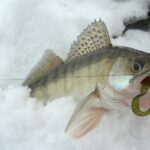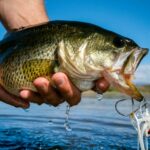Have you ever walked up to an angler and asked what the best type of bait is? You’ll usually get as many (different) answers as people you ask! So how do we answer the “burning” question on many new anglers’ minds “What is the best artificial bait for lake fishing?”
Unfortunately, there is no “one-size-fits-all” miracle artificial bait when lake fishing. The best bait suits your fishing style, the type of fish, and the environmental conditions. Anglers have personal preferences, but popular artificial baits include crankbaits, soft plastics, jigs, and spoons.
While fishing is great, there are times when catching a fish would be nice too. More often than not, the bait you use is essential to the catching process. Below we’ll examine which artificial baits are best for popular lake fish and which factors influence the best bait.
What Makes A Good Artificial Bait For Lake Fishing?
While there is no one “optimum” artificial bait when lake fishing, some are better and more effective than others, thanks to their quality, design, and what they do in the water.
The best artificial bait for any fishing is one that:
- It is attractive to the intended fish species – the fish should want to take a bite out of the bait. Some artificial baits come pre-coated with scents to attract fish, others vibrate, and some are shiny/mimic prey to trick fish into taking a bite.
- It is durable – you don’t want to replace the bait after each cast. Many anglers argue against artificial baits because they come loose/break frequently. Good quality artificial baits are more expensive but last longer.
- Facilitates your fishing style – different baits lend themselves to different techniques. A good bait synergizes with your technique and improves your catching success.
- Good artificial bait fits your fishing gear – If your equipment and bait work against each other, you won’t have any success. The right setup, weight, size, coloration, etc., are fundamental to matching gear to bait.
- Is it in your budget – fishing becomes expensive, so to ensure it doesn’t become a sour point, try shopping around for the best value-for-money options without compromising quality.
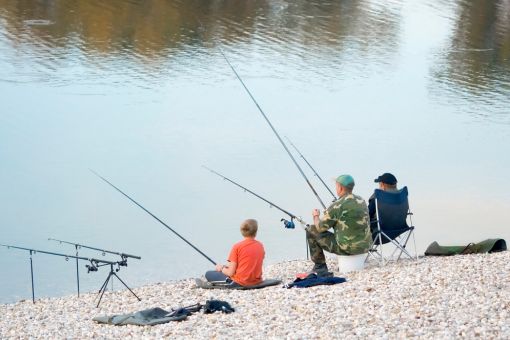
The Quintessential Factor Is Practice
While choosing the “correct” artificial bait is important, practicing fishing with your chosen bait is much more important.
Why is it so important to get the hours in?
With enough practice, you will know the following:
- How to cast the bait
- Where to cast it
- How long to leave it before retrieving
- How fast/slow do you need to retrieve it
- At what point in the process should you expect a bite
- What to do when the fish bites
- When to cut your losses
You can catch more fish with “wrong” bait that you know how to use than if you use the “right bait” incorrectly.
Without putting in the hours, you won’t clearly understand how your equipment works, reducing the likelihood of catching fish. With enough practice, you can validate to your partner why you spend so much time and money on your hobby and not the kids!
Artificial Baits Commonly Used In Lake Fishing
Artificial baits are lures, flies, or plastic “dough” manufactured to imitate prey /food items to encourage a fish to bite, leading to their being caught.
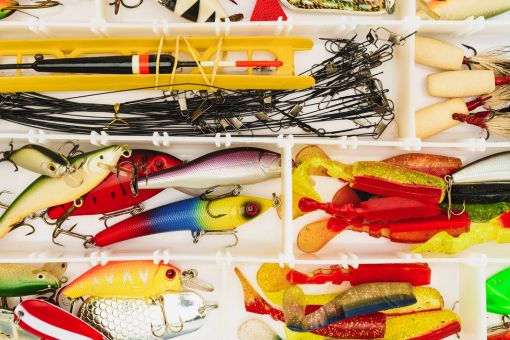
Many artificial baits and lures on the market meet different needs with pros and cons.
Below are some examples of popular artificial baits for lake fishing.
Crankbaits
Also called “plugs and minnows,” these immensely popular baits have oval, round, or flat bodies and imitate bait fish. As you reel in, these lures dive to various depths, covering vast amounts of water.
These lures come in three styles:
- Shallow divers
- Medium divers
- Deep divers
These baits are ideal for fishing near vegetation, wood (trees or piers), rocks, and open water.
Jigs
The definition for a jig-type lure is relatively broad; however, they are usually characterized by a hook fastened to a weighted head (a lead sinker) covered in feathers/a soft lure.
Jigs are most effective when anglers employ a “jigging technique.” There are also different styles of jigs, some better suited to cast and retrieve, vertical jigging, or pitching and flipping (you hold the lure and throw it in the water by hand, relatively close to where you’re standing).
While these lures move up and down the water column (vertically), they are best suited to shallow-water fishing. They require a fair amount of skill but are fantastic at encouraging fish to strike (especially when the water is cold).
Soft Plastic Baits
Many other artificial baits on this list are made of hard plastic or wood. Soft plastic baits (as the name implies) are pliable, and many don’t come with a pre-attached hook.
These baits come in various shapes and sizes, but worms, crayfish, and minnows are often the most popular varieties.
You’ll hook these around worm (straight shank) or circle hooks through the holes and indents provided on the lure.
Many soft baits are scented, releasing the attractant once in the water. The most significant issue with soft plastic bait is its limited lifespan as they deteriorate through use and eventually breaks completely.
These are some of the most effective artificial baits for many fishing conditions. They work well with jigging and spinnerbait setups.
Spinners And Spinnerbaits
While these share some similarities, the main physical difference is that spinners have one to two blades that “spin” around a straight wire. The body (usually with feathers and hooks) is connected to the wire.
A spinner bait lure has a weighted (lead) head with a wire “V.” One arm has a reflector and blades while the other holds the hook covered in feathers.
While both are effective, spinnerbait lures are ideal for fishing at the surface or right below. The vibrations and flashing attract various fish (although they are immensely popular for bass).
Walleye generally prefer spinner lures as they are lower in the water column. Both lures are great around piers, banks, and open water.
Spoons
While named for their shape, these lures mimic a minnow swimming through the water, and their metal construction reflects sunlight like bait fish do.
These are some of the simplest and most versatile lures available. Different types of spoons cater to jigging, trolling, or surface fishing.
Surface Lures
Surface lures (as the name implies) float on top (or very close to the top) of the water and mimic the look and movements of specific prey. These lures are usually hard, hollow plastic or wood with treble hooks.
Depending on the type of lure, you’ll cast and retrieve as a continuous motion, or you’ll cast and wait with the lure floating on the water/making small movements.
Popular surface lures include:
- Flies – Although generally associated with “fly fishing,” some flies are great for casting and waiting/slowing retrieving the lure.
- Other Insects – similar to flies, these lures sit on the surface and wait for interested fish to strike.
- Frogs -Manufactured to replicate the look of small to medium frogs, these lures are mostly used for largemouth bass fishing.
These slow-speed lures are fantastic for fishing around submerged vegetation. While you patiently wait for interested fish, the lure floats close to the water’s surface.
- Mice – largemouth bass (and catfish) are frequently caught on these lures. These lures are specialized, and anglers use them similarly to frog lures. As you retrieve the lure, it produces a swimming action that attracts fish.
- Lizards – similar to mice lures, these are for bass fishing. Mimicking a swimming lizard on the surface, interested fish rush up and strike.
Many of these lures are “weedless,” which means you can use them in dense vegetation with less of a chance of them getting stuck thanks to the hook’s position (buried in the lure).
Other Effective Artificial Baits For Lake Fishing
Fishing is not limited to the “popular” lures. There are many other incredibly effective lures on the market, including:
Buzzbaits
Buzzbaits imitate fast swimming, surface fish, and insects. Often black or white, these surface baits have a blade in front with a wire extending to a weighted body. Attached to the body is a hook, usually covered in a “skirt” (stands of material)/feathers.
Buzzbait lures are fantastic for covering large tracts of water, and they sink when left; however, most recommend starting reeling immediately to effectively present this bait.
They are best used early morning or evening when fish are more likely to surface (low light conditions).
Thanks to their topwater action, they are effective in dense vegetation and around other obstacles.
Dough Bait
Although not a lure, dough baits (like PowerBait) are wonderful for catching trout or catfish. These “bait balls” are made of PVC and come scented.
You mold a ball above your hook and cast it. Although most anglers use a float/bobber to keep the dough suspended in the water column, some allow it to sink to the bottom.
While you’ll often cast and leave dough baits to sit, you can also jig or troll with them.
Jerkbaits
Jerkbaits are similar to crankbaits in how they resemble small bait fish. While most are hard plastic, there are also soft plastic versions (which are ideal for fishing in dense vegetation). These versatile little lures are named for the “jerking” motion you use while fishing.
Whether slow or fast fishing, jerkbaits are an effective tool, these lures are great for fishing at various depths in the water column and work well in a plethora of water conditions (across most seasons); however, they work best in the water of around 78 °F.
They come in floating, sinking, or suspended models.
Poppers
While poppers are a type of plug/crankbait, their fundamental difference is that the front of the lure has a concave shape, which gives the lure its name. While retrieving these lures, water pushes against the “face,” which causes the lure to imitate an injured or dying fish.
These lures excel in shallow water.
Swimbaits
Where swimbait lures differ from crankbaits is that a portion of their “bodies” move as you retrieve it through the water (a paddle tail). This movement mimics a fish swimming. There are solid swimbaits too.
Depending on your target, these baits work at various depths in the water column. However, they are most popular for bass fishing.
Paddle tail versions are fantastic for shallow water and moving around obstacles like vegetation and piers.
The Fish You Target Influences Which Artificial Bait Is Best
One of the most significant variables in artificial bait selection is what fish you intend to catch. The “best” bait for one species is often not the best for a different species, so being prepared is critical.
The rule of thumb is to choose a bait replicating what your target species eats. I.e., if they eat minnows/bait fish, you’ll want a spoon or crankbait (including poppers and swimbaits), while fish that target crustaceans prefer soft plastics.
Below are some of the most commonly caught lake fish and what baits work for them.
The Best Artificial Baits For Bass
Bass are predatory fish and strike at various types of bait. Although there are some differences between large and smallmouth bass, there is considerable overlap in artificial bait preference.
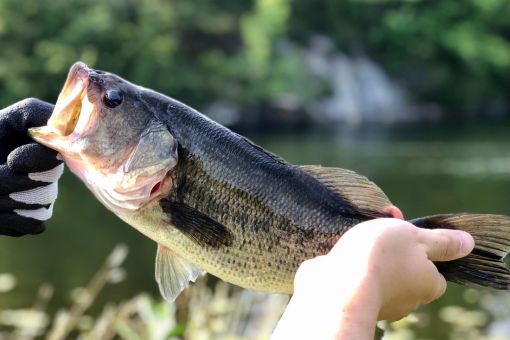
The most frequently used include:
- Buzzbaits
- Crankbaits
- Jigs
- Soft Plastic worms
- Spinnerbaits
- Swimbaits
The Best Artificial Bait For Salmon And Trout
Although salmon and trout belong to the same family (Salmonidae), these predatory fish differ in their diets.
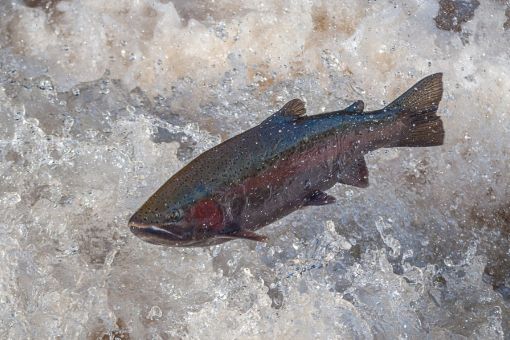
The table below examines which baits work for which Salmonidae species.
| Artificial bait | Trout/Salmon |
| Dough bait (PowerBait) | Lake Trout |
| Spinner | Arctic Salmon, Steelhead Salmon, Pink Salmon |
| Flies | Coho Salmon, Lake Trout |
| Soft plastics (like a Gulp minnow and EZ Eggs) | Chinook Salmon, Lake Trout, Steelhead Salmon, Pink Salmon |
| Jerk baits | Lake Trout |
| Crankbaits/plugs | Arctic Salmon, Chinook Salmon, Coho Salmon, Lake Trout, Pink Salmon, Steelhead Salmon |
| Spoons | Arctic Salmon, Coho Salmon, Lake Trout, Steelhead Salmon |
| Jigs (Marabou) | Chinook Salmon, Pink Salmon |
The Best Artificial Baits For Panfish Fishing
Panfish is a collective term for several fish species that fry fantastically in a pan.
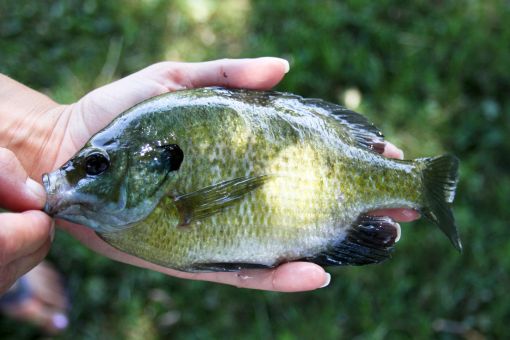
The table below examines which artificial baits work with the most frequently caught lake panfish.
| Panfish | Lure type |
| Black Crappies | Jigs, Crankbait (minnows), Jerkbaits, Soft plastic worms |
| Rock Bass | Crankbait (minnows), Jigs, Poppers, Soft plastic (worms and crawfish), Spinners (beetle), Most topwater lures and shallow diving baits |
| Sunfish (particularly Bluegills) | Jigs, Poppers, Soft plastic (worm and fish), Spinners (beetle) |
| Perch (Yellow And White) | Jigs, Crankbait (Gulp minnow), Soft plastic (worms), Spoons, Spinners |
The Best Artificial Baits For Catfish
You’ll likely catch three catfish species in a lake: Blue, Channel, and Flathead.
Catfish are renowned for eating practically anything, but some of the best artificial baits include:
- Crankbaits (rattle)
- Jigs
- Soft plastics
- Spinners
Most important for catfish is that the bait/lures are heavily scented and make some vibrations to attract the fish. However, cut and live bait generally yield better results for catfish.
The Best Artificial Baits For Walleye
Walleye are renowned for their delicate bites, so the maximum focus is essential when targeting this species.
Popular walleye artificial baits include:
- Crankbaits
- Jigs
- Soft plastic worms
- Swimbaits (paddle tails)
Other Factors That Influence Bait Suitability For Lake Fishing
While your target fish’s food preference is critical in what bait you select, other variables impact the “best bait” on the day.
Your Prefered Technique Is Fundamental In Bait Selection
What fishing style do you want to use? Casting, dropping, jigging, trolling, etc. The various methods excel with different artificial baits.
Equally important is how well you can adjust your fishing techniques to accommodate the conditions.
I.e., many anglers retrieve the lure faster in warm water and slower in cold water. However, changing the retrieval speed (often with a sharp “yank”) might cause a semi-interested fish to lunge at the fast movement.
Fishing Spot/Position On The Water Body Determines The Bait
Are you around obstacles like vegetation, sunken trees, piers/docks, or in the open water? Depending on where you fish influences which bait works best.
E.g., weedless baits, surface baits, and shallow diving baits are essential for fishing over vegetation, while a diving bait or jig is better for sinking next to where rock bass hide.
Some fish prefer deeper and colder areas, while others hang around the bank, so you’ll need to decide what fish you want and get to know where they hang out.
(https://www.shutterstock.com/image-photo/fisherman-rod-spinning-reel-on-river-1111779815)
Water Conditions Play A Critical Role In Bait Performance
The prevalent conditions play a fundamental role in what artificial bait works.
Water conditions include:
- Murkiness – how transparent the water is. In low visibility, you’ll use scented baits and bright-colored lures.
- Current strength – paddle tails (swimbaits) are fantastic in stronger currents, while a jig might be ideal for calmer waters.
- Temperature – spinnerbaits, square bill crankbaits, jerkbaits, and jigs are ideal in colder water, while soft plastics, spinnerbaits, lipless crankbaits, and topwater frogs are great in warmer water.
It’s critical to learn what your target fish does in different water conditions and to decide on bait accordingly.
Weather Conditions Influence A Bait’s Efficacy
Seasons, rainfall, and wind significantly affect how well certain artificial baits work.
For example, summer is ideal for using a mouse lure for bass fishing. The surrounding vegetation is usually dense, so fish come closer to the bank and are likelier to strike at the lure.
In winter, fish are usually sluggish and eat less, so they may only attack lures out of instinct and not out of hunger.
When there are heavy rains, bass is more likely to attack a mouse lure, as there are usually more rodents in the water during the rain. While fish might not know the details, they can determine that rain equals more food.
Strong winds may “herd” bait fish into a corner of the lake, which game fish take advantage of. So when fishing during or after the wind, check the “corners” for bass, trout, and walleye.
Conclusion
There is no “one for all and all for one” type of artificial bait; rather, the fish species, water conditions, weather/climate, and your preferred fishing techniques play fundamental roles in what bait works best. The most popular baits are usually crankbaits, jigs, spoons, and soft plastics, but a wise angler will have a wide selection and should prepare to alter techniques and equipment as required.
- Do You Need An Indicator For Nymph Fishing? - November 16, 2023
- Fishing Safety Tips For Families - September 25, 2023
- What Is The Best Time To Night Fish At A Lake? - September 18, 2023

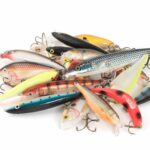

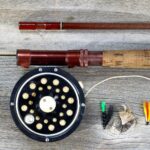
![Kayak Fishing for Beginners [10 Tips for a Successful Trip] fishing kayak moored on a beach](https://irvinelake.net/wp-content/uploads/2022/12/kayak-fishing-for-beginners-150x150.png)

